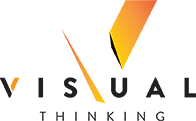
IDEAS: GROWTH IN BOTH DIRECTIONS
We are fast approaching the time when companies realize and are ready to accept the astonishing power of empowering people, and the remarkable changes that can result. Yes, people as a resource for ideas is at the core of a transformed work culture and incalculable financial benefits—as long as we are mindful of the traps. Like the ideas themselves, there are land mines we can step on. For now, I target two of them. And while you may find my remarks applicable to all ideas, everyone and any organizational level, this week I focus on ideas from hourly employees, value add associates—all visual thinkers-in-the-making.
The Challenge of the Small. As your understanding of visuality and how and why it works grows—and the visual thinkers who report to you begin to create visual solutions—pay close attention. It is now that your visual conversion is in its most delicate state because a single disparaging remark can undo the work of weeks or months. Support the small ideas. Every contribution, however humble, has a huge value at this point. That value is this: It is a beginning. And all beginnings are to be celebrated. They mark a break from the past and the promise of a tomorrow whose destination is only partly understood.
Managers and supervisors, when you see that beginning, however small, make much of it. Give congratulations, take photos, and write articles. (Except, of course, when you know—or learn—that certain people do not like a fuss made about them or even near them; then you go low-key…a quiet, private thank you is in order.) People have such willingness to contribute. Though your crew may not yet have the skill or insight to create a trackable bottom-line benefit, your recognition—quiet or rowdy—fans the ember of these early efforts. Build your own skill in envisioning the tangible benefits that small ideas can produce and watch the momentum gather. Pay attention. Notice the good and give praise. The success of your improvement initiative depends on that, as does the growth of the enterprise.
The Challenge of the Big. Likewise, some of us have very active imaginations and—invited or not—love to envision possibilities, big possibilities. This is the other end of the ideas continuum. As with tiny start-up ideas, tread carefully with the big ones. For example, in the part of operator-led visuality called Smart Placement, value-add associates are asked to re-engineer the physical layout of their areas. Even though the thinking is guided by a set of 14 principles (such as “store/things not air” and “design-to-task”), the process can be mistakenly heard as an open invitation to “change everything because we can imagine it.”
Take down that wall! Move those two machines closer together! Big ideas and neither is wrong. In fact, taking down that wall would dis-entangle the process. Great idea. But, at the moment, it is only an idea. To move it forward, we will need to vet it, technically. For example, is it safe? And even if it passes that check point, there may not be enough funds to resource it. Or the timing may be wrong for this year’s production demands. And on and on.
Protect ideas and the people who think of them: Lay down the ground rules early. For instance: Just because we think of a change doesn’t mean it has to get done—or can get done or will get done.
Not handling big ideas correctly is where many improvement initiatives crash and burn. Do not to confuse “I-driven” with open-handed permission. If you do, value-add associates might get the mistaken impression that just because they thought of an improvement, it is as good as done. That is simply not—and cannot be—so. As stated, safety, costs, and plain old timing are important decision-making factors. If you promote other expectations, associates can rightly become discouraged, even angry, when one of their big ideas is not approved.
Growth in Both Directions. Yes, big ideas are sometimes too large and small ideas can seem so tiny. But you need to allow and support both. That also means you have to make your own way through some inevitable mistakes in order to find the balance point that works for you and your company’s existing work culture. Because in finding that you grow that culture. Learning how to let the continuum of ideas flow at both ends is a local discovery, not a formula. Like Goldilocks and the Three Bears, you’ll find the fit that works for you—and it will be just right.![]()




